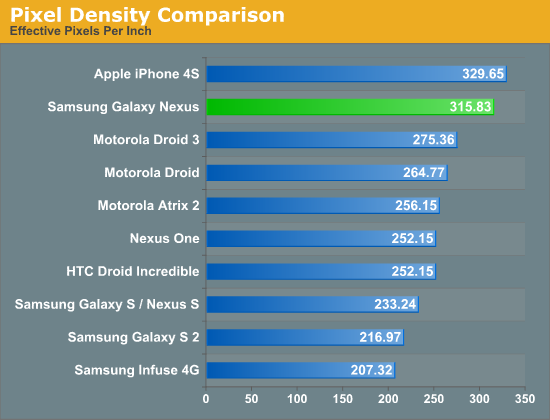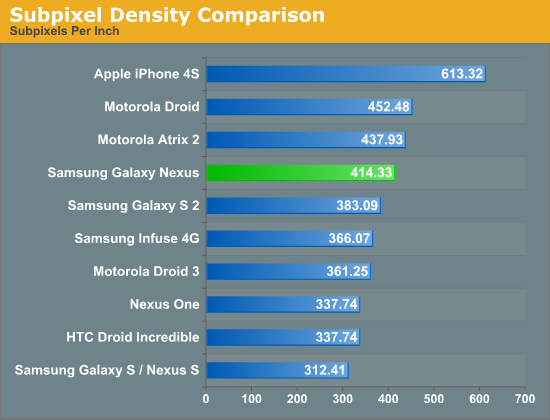Confirmed: Galaxy Nexus Includes PenTile
by Brian Klug & Jason Inofuentes on October 21, 2011 12:58 AM EST- Posted in
- Smartphones
- Samsung
- Ice Cream Sandwich
- Mobile
- AMOLED
- galaxy nexus
Though we've learned a lot about the Galaxy Nexus specifications already, one of the things that has remained a question thus far is whether its 4.65" 720p HD Super AMOLED display uses an RGB subpixel rendering layout or PenTile. We've now confirmed that the Galaxy Nexus display does in fact use RGBG PenTile, like all the Nexus devices to date. This isn't super surprising considering that Samsung has been pretty good about adhering to all the monikers it has gradually been tacking onto AMOLED. There are a number so far - 'super' connotes an optically bonded panel and digitizer stack, 'plus' connotes an RGB stripe, and now 'HD' connotes, well, 720p. HD Super AMOLED lacks Plus, and thus isn't an RGB stripe.
The next question is just what 4.65" HD Super AMOLED will look like, or whether the presence of PenTile will be as noticeable as previous AMOLED phones like the Nexus S / Galaxy S or Nexus One where it was arguably very noticeable. That said, at some subpixel density it should become difficult to impossible to notice PenTile's presence, it's just a matter of exceeding human visual acuity. Having not seen the Galaxy Nexus in person yet and given the absence of good macro shots of the display, we have put together a numerical comparison pitting the Galaxy Nexus panel up against some other common smartphone displays.
First up is a quick plot of the effective pixel density of some popular displays. Stated another way, this is the pixel density based on the manufacturer's stated logical resolution, which is also the resolution of Android's render target for the phone.

Note that this is the traditional means of reporting pixels per inch that we've published before. However, using this metric is just a bit misleading since it doesn't take into account the difference between 2 subpixel-per-pixel RGBG or RBGW PenTile versus the 3 subpixel-per-pixel RGB stripe. To make for an effective comparison, we've put together another plot where we take into account the presence of PenTile and report subpixel density.

Here things still look pretty good for the 4.65" HD Super AMOLED display, putting it just north of SGS2's Super AMOLED Plus display with an RGB stripe. I wager that if you were satisfied with the pixel density of SGS2 that the pixel density Galaxy Nexus actually won't be off-putting despite the presence of PenTile. In addition, hopefully some of the UI design considerations that come along with using PenTile (no vertical 1 pixel thick elements) have been taken into consideration from the outset for Ice Cream Sandwich. For true subjective impressions however, we'll have to wait and see.
Source: Data










152 Comments
View All Comments
OfficerX - Friday, October 21, 2011 - link
No, but I don't carry my TV in my pocket.rpmurray - Friday, October 21, 2011 - link
The furthest I can hold a 3.5" display from my eyes is 27". When I try that with a 4.65" display it's still 27". Do you have arms that grow depending on the size of the display?deV14nt - Monday, October 24, 2011 - link
The furthest isn't the number that matters. The average is the one with significance.zorxd - Monday, October 24, 2011 - link
Well, if you really hold your phone as far away as possible from your eyes, then I understand why PPI matters to you.But for normal people, PPI doesn't matter. Size and resolution do.
augustofretes - Thursday, November 10, 2011 - link
You're wrong. If you think people don't see the difference between the iPhone 4 screen and the rest is because you don't want to. DPI is nothing more but a measure of size vs pixels, and it has always been important, since it directly relates to how we perceive a screen...cbutters - Thursday, December 8, 2011 - link
You just said "PPI doesn't matter. Size and Resolution do...."What you are failing to understand is that PPI IS size and resolution. It is just a measure determined by resolution and size.
deV14nt - Friday, October 21, 2011 - link
Thanks @zorxd for mentioning that the total number of pixels or subpixels of the whole display, if you demand to discuss only one measure alone, is a better approximation of the display's characteristics. The diagonal alone is 33% bigger on the Galaxy Nexus. These displays are not even in the same class. And it seems really silly that so many respectable tech sites are comparing them as if they are.It's like comparing a 40" to a 53" TV, yet all these tech sites seem obsessed with the pixel density, ignoring the fact that it means little without simultaneously looking at the screen size. Apparently we are as obsessed with technical minutiae as we are with holding our phones way too freaking close to our heads. At least some of us, those who can't see the forest for the trees.
All of this ignores the fact that the contrast ratio for the Galaxy Nexus is 100,000 to 1 compared to the iPhone 4S at 800:1. Again, these screens are not even in the same class. Colors are also more vivid (which I'm sure can be measured), and to balance things out you could have mentioned maximum brightness is sacrificed.
Instead we get an article with some charts that aren't nearly as relevant as they are made out to be. Why is this not more comprehensive?
retnuh - Friday, October 21, 2011 - link
You missed the whole printer DPI battle during the 90s didn't you?High DPI or in this case PPI is a good thing, but you're measuring it wrong. You want high PPI in X inches, whether X is 3.5", 4.65", 23", then you figure the actual resolution that would be required to make it happen.
So using your example a 23" screen at 1920x1080 is roughly 96 PPI. It'd take a 23" display at 5760x3240 to get a PPI of ~287. With resolution independence needed for that sort of high PPI everything would appear razor sharp.
Your 300 PPI 1024x768 example would leave you with a 4.25" display which as you said isn't a very useful desktop monitor, but in a phone it'd be great.
This is ignoring all the subpixel stuff from above and assuming a 1:1.
zorxd - Friday, October 21, 2011 - link
I agree with you. You always want the highest resolution possible on a given screen size. I prefer a 1280x720 4.65" display over a 800x480 4.65" display.But I don't see the point in comparing the density between screens of different sizes.
A 1280x720 resolution is better than a 960x640 resolution. Whether you prefer a 3.5" display or a 4.65" display is a matter of taste, I guess.
CPD - Friday, October 21, 2011 - link
"Burt I don't see the point in comparing the density between screens of different sizes."When we're talking about devices that are within a couple of inches of one another, it's not obscene to discuss the density. It makes plenty of sense. Both will be used within an arms length, which means that if one has a lesser pixel density than the other, the pixels will be more visible on the display. Of course, it may not bother some.